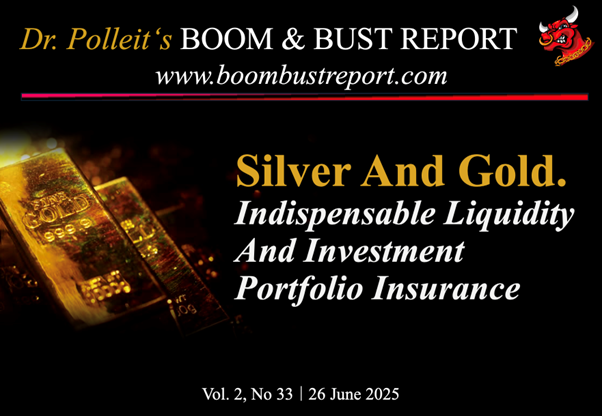(Kitco Commentary) - The price development for silver and gold has been nothing short of spectacular over the last three years. The price of silver (in U.S. dollars) has risen by 67 per cent, with a 17 per cent increase in the last twelve months. The price of gold (also in U.S. dollars) has performed even better, with a price increase of 83 per cent over the last three years and a 43 per cent rise compared to the previous year. At the same time, the interest of many (private) investors in silver and gold as an investment has significantly increased. However, in such bull-market-phases, it is well known that price exaggerations can easily occur. Therefore, it may be useful to take a closer look at the long-term price data for gold and silver to draw some lessons from their historical price development for the present.
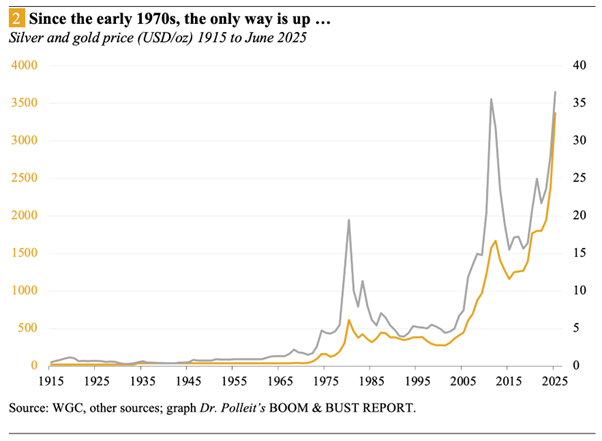
Figure 2 shows the gold and silver prices from 1915 to June 2025. It should first be noted that the price of gold was, in the truest sense, fixed until the late 1960s: it could not freely form in the market, as was the case with the silver price. There was only one change in the gold price during this time: on January 30, 1934, U.S. President Franklin D. Roosevelt (1882–1945) increased the price of gold to 35 US dollars per troy ounce from the previous 20.67 U.S. dollars per troy ounce. Thus, the relative price changes between the two precious metals from 1915 to 1968/1969 were de facto driven by movements in the silver price. The time series further reveal a positive and relatively close correlation: rising (falling) gold prices were accompanied by rising (falling) silver prices—which may also explain why gold investors are typically also silver investors (and vice versa. However, Figure 2 does not reveal the significantly different price increases and price volatility of gold and silver. Taking the period from 1969 (when the gold price began to detach from its official fixing) to June 2025 as a basis, the gold price has increased by an average of 8.2 per cent per year, while the silver price has risen by an average of only 5.5 per cent per year. This is actually a fairly significant difference, especially when viewed over long periods. For example, 100 U.S. dollar invested at 8.2 per cent per year would grow to approximately 484 U.S. dollar after 20 years, while at 5.5 per cent, it would only reach about 292 U.S. dollar. Gold has clearly ‘outperformed’ silver in this regard. Additionally, gold price fluctuations were less pronounced than those of silver: for the period from 1969 to June 2025, the standard deviation of annual gold price changes was 23.2 per cent, compared to 29.9 per cent for silver.
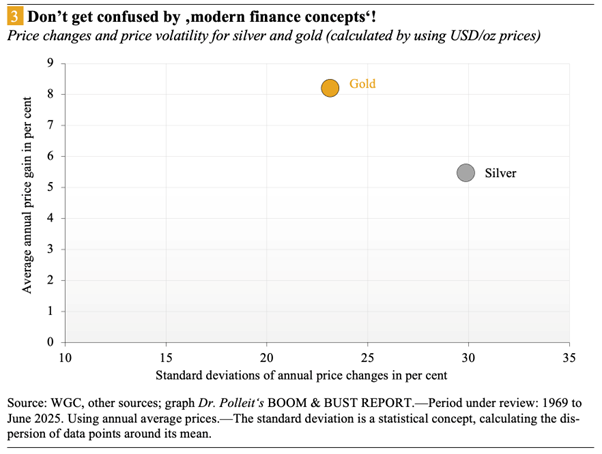
Figure 3 illustrates the relationship between price increases (vertical axis) and price volatility (horizontal axis) of the precious metals for the period from 1969 to June 2025. How should the graph be interpreted? Well, an investor generally desires high returns with the lowest possible risk. (Admittedly, classifying the standard deviation of price changes as "risk," as done in this graph, must be questioned. But for illustrative purposes, we adopt this perspective here. See also Box 3.) Again, gold, one could say, has outperformed silver: it achieved a higher price increase while its price volatility was lower compared to the price development and volatility of silver.
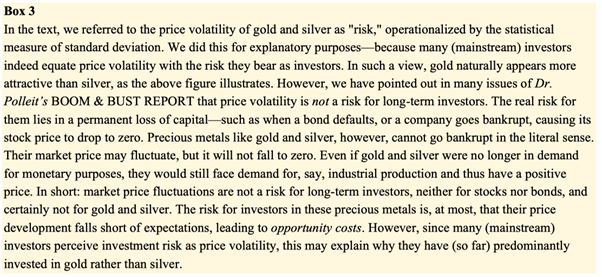
Thus, one could say: purely based on price performance, it has been more advantageous for long-term investors to hold gold rather than silver. However, such a simple "average perspective" overlooks the fact that there have been periods when the silver price significantly outperformed the gold price or when silver experienced smaller losses than gold. This becomes clear when looking at the gold-silver price ratio, as shown in Figure 4.
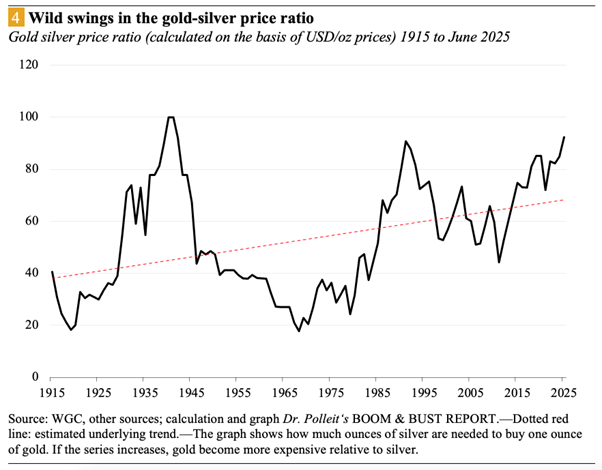
Examining the period from 1915 to June 2025, significant fluctuations are evident. The gold-silver price ratio reached a record high of 100 in 1941 and a record low of 17.8 in 1968. Additionally, it shows an upward trend, meaning the gold-silver price ratio has fluctuated around a rising mean over time. This trend seems to have started particularly since the late 1960s (with the end of official gold money), illustrating what we have already explained: on average, over the years, the gold price has risen more strongly than the silver price.
Moreover, it should be emphazised that interpreting the gold-silver price ratio is not entirely straightforward. A rising gold-silver price ratio could mean that the gold price is rising faster than the silver price, or that the silver price is falling more sharply than the gold price. If, for example, the gold-silver price ratio is above its trend value (as indicated by the red dashed line in Figure 4), one might expect it to revert to this trend over time. This could happen either by the gold price rising less than the silver price or by the silver price falling less than the gold price.
The point is: the gold-silver price ratio does not provide immediate or "mechanical" actionable recommendations. For instance, if the gold-silver price ratio is unusually high, it does not necessarily mean one should buy silver and sell gold. For the ratio could also revert by the silver price falling less than the gold price, leading to losses in both metals for the investor. Rather, careful consideration of the respective circumstances and a sense of intuition are required. Our current interpretation is as follows:
(1.) The prices of gold and silver are in a "bull market," without question. This development, as of today, is supported by fundamental factors—particularly the growing risks in the international financial architecture, further fuelled by increasing conflicts and wars.
(2.) The underlying long-term trend value for the gold-silver price ratio is currently at 68.2, while the actual value is around 92. In a bull market, a return to the trend value is likely to occur through a stronger rise in the silver price relative to the gold price. Specifically: there are good reasons to assume that the silver price will outperform (if the gold price remains at its current level or edges up further), moving from its current level of approximately 36 U.S. dollars per troy ounce toward 49 U.S. dollars per troy ounce, a price increase of about 36 per cent.
In this article, we have focused on historical data. While this is informative, it should not lead to the expectation that the future price development of gold and silver (relative to each other) must follow historical patterns. On the contrary: the economic and political changes expected globally could drive gold and silver prices much higher and, due to unforeseen events, in ways that historical price patterns do not suggest. Even if precious metal prices were to decline sharply in the short term, investors are well advised to maintain a long-term perspective and hold onto their precious metal positions. At the end of the day, one thing is particularly important: silver and gold are not only liquid assets in an investment portfolio that will retain their exchange value, especially in turbulent times as the fiat money system now increasingly faces. They are also an insurance for the investment portfolio, with (unlike bank deposits) no default or fulfilment risk.
Two final thoughts: First, for gold investors concerned about a potential gold ban or other government interventions that could impair the liquidity and fungibility of gold, a silver position is a natural "diversification option." Second, we have long believed that the "relatively low" silver price is a barrier for investors. Why? The following example gives an explanation: if you want to invest 50,000 U.S. dollars in gold, at the current gold price of 3,367 US dollars per troy ounce, this corresponds to 14.85 troy ounces or 0.46 kilograms—a quantity and weight that is relatively easy to handle (in terms of transport and storage). However, if you want to invest 50,000 U.S. dollars in silver, you will need to buy 1,389 troy ounces, equivalent to 43.2 kilograms. Thus, holding silver is more "cumbersome" for investors at the current "low" price. However, if the silver price continues to rise, we believe silver will become (significantly) more attractive to investors, driving its price even higher. This aspect also supports the case for long-term investors to hold silver in their portfolios.
This article is from Dr. Polleit’s BOOM & BUST REPORT, Vol. 2, No. 33, 26 June 2025. If you want to learn more, visit the website: www.boombustreport.com/english

